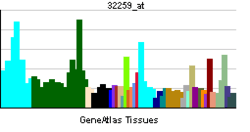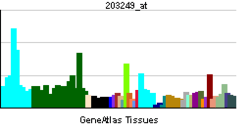EZH1
| Enhancer of zeste 1 polycomb repressive complex 2 subunit | |||||||||||||
|---|---|---|---|---|---|---|---|---|---|---|---|---|---|
| Identifiers | |||||||||||||
| Symbols | EZH1 ; KMT6B | ||||||||||||
| External IDs | OMIM: 601674 MGI: 1097695 HomoloGene: 20458 IUPHAR: 2835 GeneCards: EZH1 Gene | ||||||||||||
| EC number | 2.1.1.43 | ||||||||||||
| |||||||||||||
| RNA expression pattern | |||||||||||||
 | |||||||||||||
 | |||||||||||||
| More reference expression data | |||||||||||||
| Orthologs | |||||||||||||
| Species | Human | Mouse | |||||||||||
| Entrez | 2145 | 14055 | |||||||||||
| Ensembl | ENSG00000108799 | ENSMUSG00000006920 | |||||||||||
| UniProt | Q92800 | P70351 | |||||||||||
| RefSeq (mRNA) | NM_001991 | NM_007970 | |||||||||||
| RefSeq (protein) | NP_001982 | NP_031996 | |||||||||||
| Location (UCSC) | Chr 17: 40.85 – 40.9 Mb | Chr 11: 101.19 – 101.23 Mb | |||||||||||
| PubMed search | |||||||||||||
Histone-lysine N-methyltransferase EZH1 is an enzyme that in humans is encoded by the EZH1 gene.[1][2]
Function
In mice, EZH1 and EZH2 cogovern histone H3K27 trimethylation and are essential for hair follicle homeostasis and wound repair.[3] EZH1 also complements EZH2 in maintaining stem cell identity and executing pluripotency.[4]
References
- ↑ Abel KJ, Brody LC, Valdes JM, Erdos MR, McKinley DR, Castilla LH, Merajver SD, Couch FJ, Friedman LS, Ostermeyer EA, Lynch ED, King MC, Welcsh PL, Osborne-Lawrence S, Spillman M, Bowcock AM, Collins FS, Weber BL (Feb 1997). "Characterization of EZH1, a human homolog of Drosophila Enhancer of zeste near BRCA1". Genomics 37 (2): 161–71. doi:10.1006/geno.1996.0537. PMID 8921387.
- ↑ "Entrez Gene: EZH1 enhancer of zeste homolog 1 (Drosophila)".
- ↑ Ezhkova E, Lien WH, Stokes N, Pasolli HA, Silva JM, Fuchs E (Mar 2011). "EZH1 and EZH2 cogovern histone H3K27 trimethylation and are essential for hair follicle homeostasis and wound repair.". Genes Dev. 25 (5): 485–98. doi:10.1101/gad.2019811. PMC 3049289. PMID 21317239.
- ↑ Shen X, Liu Y, Hsu YJ, Fujiwara Y, Kim J, Mao X, Yuan GC, Orkin SH (Nov 2008). "EZH1 mediates methylation on histone H3 lysine 27 and complements EZH2 in maintaining stem cell identity and executing pluripotency.". Mol Cell. 32 (4): 491–502. doi:10.1016/j.molcel.2008.10.016. PMC 2630502. PMID 19026780.
Further reading
- Rommens JM, Durocher F, McArthur J et al. (1996). "Generation of a transcription map at the HSD17B locus centromeric to BRCA1 at 17q21.". Genomics 28 (3): 530–42. doi:10.1006/geno.1995.1185. PMID 7490091.
- Brody LC, Abel KJ, Castilla LH et al. (1995). "Construction of a transcription map surrounding the BRCA1 locus of human chromosome 17.". Genomics 25 (1): 238–47. doi:10.1016/0888-7543(95)80131-5. PMID 7774924.
- Osborne-Lawrence S, Welcsh PL, Spillman M et al. (1995). "Direct selection of expressed sequences within a 1-Mb region flanking BRCA1 on human chromosome 17q21.". Genomics 25 (1): 248–55. doi:10.1016/0888-7543(95)80132-6. PMID 7774925.
- Friedman LS, Ostermeyer EA, Lynch ED et al. (1995). "22 genes from chromosome 17q21: cloning, sequencing, and characterization of mutations in breast cancer families and tumors.". Genomics 25 (1): 256–63. doi:10.1016/0888-7543(95)80133-7. PMID 7774926.
- Nagase T, Ishikawa K, Nakajima D et al. (1997). "Prediction of the coding sequences of unidentified human genes. VII. The complete sequences of 100 new cDNA clones from brain which can code for large proteins in vitro.". DNA Res. 4 (2): 141–50. doi:10.1093/dnares/4.2.141. PMID 9205841.
- Ogawa M, Hiraoka Y, Taniguchi K, Aiso S (1998). "Cloning and expression of a human/mouse Polycomb group gene, ENX-2/Enx-2.". Biochim. Biophys. Acta 1395 (2): 151–8. doi:10.1016/s0167-4781(97)00156-5. PMID 9473645.
- Jones CA, Ng J, Peterson AJ et al. (1998). "The Drosophila esc and E(z) proteins are direct partners in polycomb group-mediated repression.". Mol. Cell. Biol. 18 (5): 2825–34. PMC 110661. PMID 9566901.
- van Lohuizen M, Tijms M, Voncken JW et al. (1998). "Interaction of mouse polycomb-group (Pc-G) proteins Enx1 and Enx2 with Eed: indication for separate Pc-G complexes.". Mol. Cell. Biol. 18 (6): 3572–9. PMC 108938. PMID 9584197.
- Strausberg RL, Feingold EA, Grouse LH et al. (2003). "Generation and initial analysis of more than 15,000 full-length human and mouse cDNA sequences.". Proc. Natl. Acad. Sci. U.S.A. 99 (26): 16899–903. doi:10.1073/pnas.242603899. PMC 139241. PMID 12477932.
- Gerhard DS, Wagner L, Feingold EA et al. (2004). "The status, quality, and expansion of the NIH full-length cDNA project: the Mammalian Gene Collection (MGC).". Genome Res. 14 (10B): 2121–7. doi:10.1101/gr.2596504. PMC 528928. PMID 15489334.